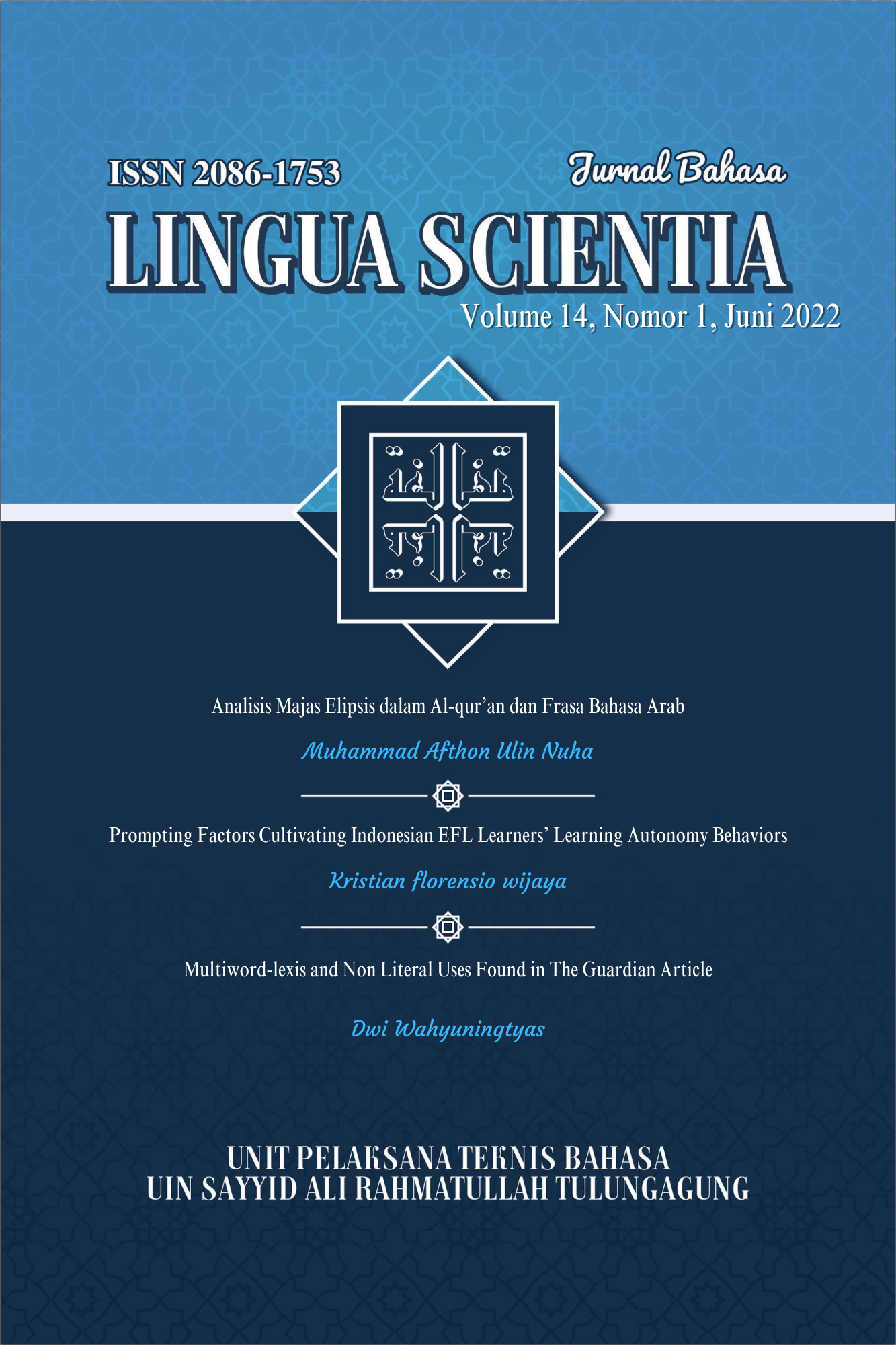EXPLORING STUDENTS’ RESPONSES TO THE “MISSYOU” LYRIC GAME ON LEARNING LISTENING
Abstract
The purpose of this study is to see how students react to using the "Missyou" Lyric Game in listening activity. This study uses a qualitative research design. The participants in this study were 20 students from SMPN 1 Srengat who were chosen at random. A questionnaire was used to gather information. The purpose of the questionnaire is to collect student responses and determine whether the "Missyou" Lyric Game model explores and develops students' listening ability as an alternative media for learning to listen. The results revealed that 81,65 percent of respondents agreed that song lyrics may enhance their listening skills.
Downloads
References
Alfin, J. (2011). Bahasa Indonesia. PMN.
Allan, G. (2020). Qualitative research. In Handbook for research students in the social sciences (pp. 177–189). Routledge. https://www.taylorfrancis.com/chapters/edit/10.4324/9781003070993-18/qualitative-research-graham-allan
Arsyad, A. (2011). Media pembelajaran. Jakarta: PT Raja grafindo persada.
Baills, F., Zhang, Y., Cheng, Y., Bu, Y., & Prieto, P. (2021). Listening to songs and singing benefitted initial stages of second language pronunciation but not recall of word meaning. Language Learning, 71(2), 369–413.
Diakou, M. (2013). Using songs to enhance language learning and skills in the Cypriot primary EFL classroom. Open University (United Kingdom).
Hamouda, A. (2013). An exploration of causes of Saudi students’ reluctance to participate in the English language classroom. International Journal of English Language Education, 1(1), 17–34.
Huberman, A. M., Miles, M., & Saldana, J. (2014). Qualitative data analysis: A methods sourcebook. The United States of America: SAGE Publications.
Huberman, M., & Miles, M. B. (2002). The qualitative researcher’s companion. Sage. https://www.odvozknih.cz/sites/odvozknih.cz/files/filefield_paths/pdf-qualitative-data-analysis-a-methods-sourcebook-matthew-b-miles-a-michael-huberman-johnny-saldaa-pdf-download-free-book-7e6e67f.pdf
KEMALOGLU-ER, E., & SAHIN, M. T. (2022). Project-Based Learning in English Language Teaching at a Rural School: A Case Study from Turkey. Novitas-ROYAL (Research on Youth and Language), 16(1), 34–55.
Lestary, N. L. G. W. (2019). THE USE OF SONGS TO IMPROVE STUDENTS’LISTENING COMPREHENSION ABILITY. Yavana Bhasha: Journal of English Language Education, 2(2), 34–45.
Maharani, R., & Sari, H. (2022). Developing Mobile Application Based on Android for Learning Vocabulary for Grade Ten. Advances in Educational Technology, 1(1), 23–30.
Miles, Mattheu B, & Huberman, A. M. (1984). Qualitative data analysis: A sourcebook of new methods. In Qualitative data analysis: a sourcebook of new methods. Sage publications. http://bases.bireme.br/cgi-bin/wxislind.exe/iah/online/IsisScript=iah/iah.xis&src=google&base=PAHO〈=p&nextAction=lnk&exprSearch=19555&indexSearch=ID
Miles, Matthew B, & Huberman, A. M. (1992). Analisis data kualitatif. Jakarta: UI press.
Millington, N. T. (2011). Using songs effectively to teach English to young learners. Language Education in Asia, 2(1), 134–141.
Muftihah, N. (n.d.). Keterampilan Berbahasa Menyimak Film.
Newton, J. M., & Nation, I. S. P. (2020). Teaching ESL/EFL listening and speaking. Routledge.
Prasmono, A. (2011). Pengaruh Penggunaan Media Pembelajaran Komputer Multimedia Dan Digital Video Disc Terhadap Prestasi Belajar Listening Ditinjau Dari Motivasi Belajar Siswa Sekolah Menengah Pertama Di Kabupaten Wonogiri. UNS (Sebelas Maret University).
Sari, H. P., Fauzi, A., & Primasari, Y. (2020). KREASI BAHAN AJAR BERKONSEP GAME UNTUK PEMBELAJARAN EKSTRAKURIKULER BAHASA INGGRIS TINGKAT SEKOLAH DASAR. Abdimas Bela Negara, 1(2), 51–63.
Sari, H. P., & Hestiningrum, Y. S. P. (2019). PENGEMBANGAN SNAKE AND LADDER GAME SEBAGAI MEDIA PEMBELAJARAN PADA MATA KULIAH VOCABULARY SEMESTER III UNIVERSITAS ISLAM BALITAR. Konstruktivisme: Jurnal Pendidikan Dan Pembelajaran, 11(2), 163–175. https://ejournal.unisbablitar.ac.id/index.php/konstruktivisme/article/view/724
Sari, H. P., & Lestari, W. D. (2020). Designing Superlary Game to Learn Vocabulary of Tenth Grade Students. EDUCATIO: Journal of Education, 5(2), 159–168.
Sari, H. P., & Sintia, A. D. (2021). DEVELOPING AUDIO MEDIA FOR TEACHING LISTENING. Konstruktivisme: Jurnal Pendidikan Dan Pembelajaran, 13(1), 37–51. https://doi.org/https://doi.org/10.35457/konstruk.v13i1.1096
Selviana, Y., Mannahali, M., & Dalle, A. (2020). Hubungan antara Penguasaan Kosakata dengan Kemampuan Menyimak Bahasa Jerman Siswa Kelas XI Bahasa. Interference: Journal of Language, Literature, and Linguistics, 1(2), 148–152.
Sugiyono. (2008). Metode penelitian pendidikan:(pendekatan kuantitatif, kualitatif dan R & D). Alfabeta.
Copyright (c) 2022 hesty puspita sari

This work is licensed under a Creative Commons Attribution-NonCommercial 4.0 International License.
Before going to review process, all manuscripts will be checked that they are free from plagiarism practice using "Turnitin" software. If there is an indication of plagiarism, the manuscript will instantly be rejected.


